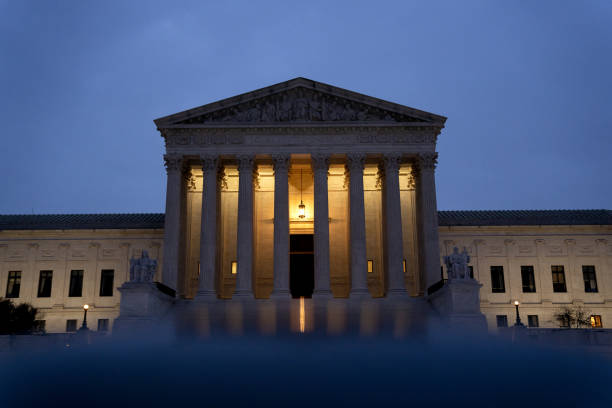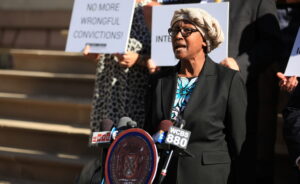
The U.S. Supreme Court Court in Washington, D.C., U.S. Photographer: Stefani Reynolds/Bloomberg
The term affirmative action dates back as early as 1935, when it was used to describe the treatment of union laborers. “Affirmative Action” appears in the 1935 Wagner Act, which President Franklin Roosevelt signed to enshrine employees’ right to form and join unions. It says:
“ If upon the preponderance of the testimony taken, the Board shall be of the opinion that any person named in the complaint has engaged in or is engaging in any such unfair labor practice, then the Board shall state its findings of fact and shall issue and cause to be served on such person an order requiring such person to cease and desist from such unfair labor practice, and to take such affirmative action including reinstatement of employees with or without backpay…”
It states, simply, that employers can’t unfairly discriminate against union laborers. And if the discrimination did occur, it required employers to act restoratively for their violations. In 1937, Supreme Court ruled in favor of the Wagner Act. But while the idea of affirmative action grew its roots in the soil of the labor movement, it wasn’t until decades later that the term became directly tied with race.
The Supreme Court’s Recent Ruling
Last week, the Supreme Court declared, in the now very familiar 6-3 majority, that affirmative action in college admissions policies is unconstitutional.
Many view the ruling as another occurrence in a string of decisions where the Supreme Court seemingly throws out decades of prior rulings. For example, this same week, the Supreme Court ruled in favor of a Colorado wedding website designer’s refusal to serve LGBTQ+ customers on the grounds that it violated free speech rights granted to them in the first amendment. In his opinion write-up, Justice Neil Gorsuch wrote, “The First Amendment envisions the United States as a rich and complex place where all persons are free to think and speak as they wish, not as the government demands.” This case is yet another in the court’s campaign to break down the constitutions clear call for a wall between church and state.
The affirmative action case, Students for Fair Admissions v. President and Fellows of Harvard College, is yet another domino in a series of opinions that goes against a long precedented history. This time around, the court has deemed it unconstitutional for college admissions programs to consider race as a scorable factor in college applications.
Roberts used the 14th amendments Equal Protection Clause as grounds for a constitutional violation. He wrote, “[T]he Harvard and UNC admissions programs cannot be reconciled with the guarantees of the Equal Protection Clause…Both programs lack sufficiently focused and measurable objectives warranting the use of race, unavoidably employ race in a negative manner, involve racial stereotyping, and lack meaningful endpoints. We have never permitted admissions programs to work in that way, and we will not do so today.”
Affirmative Action as it Relates to Race
President John F. Kennedy was the first to apply the term affirmative action in relation to racial equality. Executive Order 10925, signed in March 1961, mandates that government contractors must “take affirmative action to ensure that applicants are employed and that employees are treated during employment, without regard to their race, creed, color or national origin.” Kennedy’s order, however, failed to establish clear definitions of fair treatment.
It wasn’t until the Johnson Presidency that affirmative action began to take a visible form and address the history of inequality suffered by black and minority communities in the United States. Johnson signed Executive Order 11246 in 1965, which superseded Kennedy’s order, and implemented a specified director for monitoring affirmative action efforts within federal contracting, ordering placement goals for minorities. He also expanded on Kennedy’s order by including women to be protected from unfair discrimination.
Rolling Back the Clock to 1978
As the Civil Rights movement pressed forward, many colleges adopted affirmative action orientations to their admission policies. It wasn’t long before these policies caused a stir.
The first Supreme Court ruling about race and college admissions policy is Regents of the University of California v. Bakke. Bakke was a white student denied admission twice to the University of California, even though he had higher test scores than all the minority applicants. At the time, the school reserved 16 spots out of the entry class of 100 for minority applicants, an effort to address long-standing exclusion and discrimination of minorities in medicine.
The Supreme Court ruled that, although instituting racial quotas violated the 14th Amendment, using race as a factor was constitutional for promoting diversity and educational opportunities to the historically disenfranchised.
As things have progressed, this has been the general stance of college admission policies. Race can remain a factor in decision-making but cannot be mandated in the admissions process.
This is where the recent ruling overturns the decades of precedent. It states that admissions programs can no longer use race in decision-making. Although how Roberts addressed this in his leads to concerns, as he stated college admissions officers can consider race in terms of the part of the personal essay portion of the application.
It’s also important to note that the court’s majority opinion made an exception for affirmative action for military universities.
Affirmative Action as It Relates to the 2024 Election
The collapse of affirmative action in college admissions policies was clear from far off. Ever since the confirmation of Amy Comey Barret, issues of abortion, separation of church and state, and affirmative action all seemed destined to fall apart under a united conservative bench.
Trump, is already credit-claiming for the result of the affirmative action ruling on the campaign trail. In New Hampshire, on the day of the ruling, Trump said, “I am honored to have played a role in appointing three of the justices that ensured today’s welcomed decision, and as president, I will continue to appoint judges who will strictly apply the law rather than twisting it to serve woke and progressive ends,” It makes sense, especially given that issues like anti-affirmative action play with ubiquitous approval among Trump’s base.





